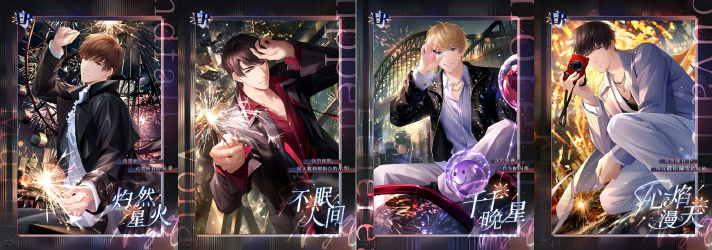
Dear Player, welcome to the world of otome games. Here, you’ll step into the life of a young woman and enter a realm filled with romance and fantasy.
Take Mr. Love: Queen’s Choice, one of the most popular Chinese otome games, released in 2017 by mobile game developer Paper Games as the country’s first title in this genre, for example. In this game, you’ll meet four men, each with unique backgrounds and captivating personalities.
There’s a playful pop star who surprises you with his depth of care; a cool and calm genius scientist who hides a quiet strength; a wealthy yet distant executive who gradually reveals his vulnerabilities; and a reliable older brother figure who also serves as your no-nonsense business partner.
As you navigate challenges and make important decisions, you’ll shape a destiny that’s uniquely yours.
According to Aurora Mobil, a Chinese mobile data solutions platform, Mr. Love: Queen’s Choice boasts an impressive 94.2-percent female player base, with more than 90 percent of players under the age of 30.
But this isn’t just about following a story; this is the magic of otome games.
Winning hearts
Otome games originated as a niche genre in Japan during the late 1990s, primarily designed for handheld consoles and PCs.
These narrative-driven games allowed players to form romantic relationships with male characters through their choices, which quickly resonated with young women seeking engaging storytelling.
Over the years, otome games have gained immense popularity and evolved into more immersive experiences, featuring rich narratives and complex character development.
In China, the otome game market has emerged more recently, building on the success of its Japanese predecessor while adapting the genre to fit local cultural contexts.
In addition to Mr. Love: Queen’s Choice, several other titles have attracted fans with their stunning graphics and intricate storylines. These include Love and the Deep Space by Paper Games, Tears of Themis by HoYoverse and Light and Night by Tencent Games.
Each of these games offers a unique take on the otome formula, providing players with engaging narratives and memorable characters to connect with.
“The main difference between Japanese and Chinese otome games lies in their business models and narrative structures,” Guo Meng, a narrative designer for otome games, told New Weekly magazine.
In Japanese otome games, players typically pay a one-time fee to access the entire game. They select a male lead and engage with a self-contained storyline that focuses on slow-paced, detailed character development.
In contrast, Chinese otome games often require players to invest time in completing tasks and may also encourage spending money to unlock new story chapters. These games tend to feature faster-paced romantic interactions and often introduce suspense early in the narrative to motivate spending. The plot continues to evolve with regular updates, creating a dynamic and ongoing experience.
A digital dreamboat
Guo, who transitioned from a career in film to writing for otome games, explained that the two roles share many similarities. The first step in creating a script, whether for a film or a game, is always to write detailed character profiles.
In otome games, male protagonists often fit familiar archetypes—CEOs, doctors, police officers, lawyers and artists—roles that resonate with players and possess universal appeal. “When I design characters, I make sure to explore their hidden vulnerabilities to add contrast and complexity,” Guo told New Weekly.
Take Li Zeyan (Victor) from Mr. Love: Queen’s Choice, for example. He has won the hearts of millions of women since the game’s release. Wang Tianchen, a player from Beijing, described him as “the perfect balance.”
“He’s successful and confident, but he also respects the female protagonist,” Wang shared with Beijing Review. “It’s not just about him being in control—he values her opinions and ambitions. That’s what makes him stand out.”
For Wang, her connection to otome game characters goes beyond mere entertainment; it’s an emotional experience. “Even though he’s a virtual character, it feels like he’s right there beside me. Sometimes, the game even has him call me, making the experience feel like real companionship,” she said.
Through Victor, Wang feels like she has gained insight into what mature, thoughtful love could look like—something she hadn’t fully experienced before. She also appreciates how the game addresses themes of sexuality in a natural, unrestrained way. “In real life, we’re often taught that sexual expression is taboo. But in this game, especially with Victor, the approach feels very natural. It’s not over-sexualized, but it’s not repressed either.”
However, this connection wasn’t without its challenges. “Eventually, I stopped playing when I noticed a change in Victor’s portrayal. His personality no longer matched the version I had first experienced. It felt like he had become a product—something that could change depending on the game developers or designers. That inconsistency broke my immersion.”
Writing a 15- to 30-minute storyline for an otome game can involve crafting thousands of words, Guo explained. In addition to the main plot and romance arcs, scriptwriters must also incorporate smaller details within the game—like text messages, phone calls, social media posts, news updates and side stories—that contribute to a cohesive gaming world. “These elements may seem trivial, and players might not even notice them, but they are essential for creating an immersive experience,” she said.
The real challenge, she added, lies in ensuring every player interaction resonates. “It’s a delicate balance. If the content isn’t engaging enough, players will lose interest after just a few clicks.”
Romance reimagined
According to a report by Chinese market research and consulting service provider Insight and Info, female players now account for a larger share of the gaming population, increasing from 19 percent in 2018 to 25 percent in 2023. The market for female-targeted games has become one of the fastest-growing segments in the gaming industry, with a value of 95.8 billion yuan ($13.1 billion). Its user base has surpassed 300 million.
Among these players, some are willing to spend substantial amounts on their virtual relationships. Take Xuan Xuan, an office worker born in the 1980s, for instance. Over the course of 10 months, she has spent 430,000 yuan ($58,953) on her favorite otome games.
“I’ve played many games aimed at a general audience, but otome games are different. They speak to what I love: romantic stories starring male characters who aren’t just pretty faces but also complex, emotional beings,” the player in U.S. told Beijing Review.
Most of her spending goes toward buying virtual cards of male characters and unlocking new storylines that reveal deeper insights into the characters’ backstories, hidden vulnerabilities, and, of course, their affection for her. “I want to experience everything—the plot twists, the romantic moments. And to get there faster, I’m willing to spend,” she said.
Plot twist?
Some critics worry that otome games might hinder players from forming real-life intimate relationships. Guo said she disagrees, noting that most players can easily distinguish between the virtual and real worlds. “The majority of otome players are women aged 18 to 30, a time of considerable life changes. The female protagonists in otome games have become more independent and self-assured, mirroring the personal growth of the players themselves,” she explained.
Xuan echoed this perspective, sharing that otome games helped her become patient in waiting for the right relationship while also teaching her valuable lessons. “I didn’t want to settle for less. But now that I’m in a committed relationship, I see otome games as a reminder to appreciate the small loving gestures that make a relationship special. They’ve shown me that love isn’t just about grand gestures; it’s about the little moments that show you care.”
Wang does believe that the portrayal of female protagonists in these games often falls into stereotypical patterns. She thinks that increasing the number of female designers and creators in the industry can help reduce these clichés. “They could take a bolder approach and create truly strong, independent female protagonists with more complex and empowered roles in the story,” she said.
Despite these limitations, otome games continue to provide a space where women can explore love on their own terms, crafting stories that are as unique as the players themselves.
As the industry evolves, it’s clear that these games are here to stay, offering a form of digital romance that is as empowering as it is captivating. –The Daily Mail-Beijing Review news exchange item




